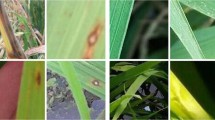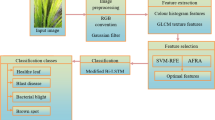Abstract
This research aims to identify rice diseases, namely Leaf blast, Brown spot, Healthy and Hispa. The purpose of this research is to utilize deep convolutional neural network (DCNN) with support vector machine (SVM), DCNN with artificial neural network (ANN) and DCNN with long short-term memory (LSTM). To enhance the performance of LSTM further, the research includes particle swarm optimization, artificial fish swarm optimization (AFSO) and efficient artificial fish swarm optimization (EAFSO) to identify optimal weights. This research also compares the proposed technique results with a conventional feature extraction approaches like texture, discrete wavelet transforms and color histogram with SVM, ANN and LSTM. The results exhibit the superiority of proposed DCNN-LSTM (EAFSO) technique over other techniques. The proposed technique EAFSO associates DCNN-LSTM identifies the rice diseases with 97.5% accuracy, which is better than DCNN-SVM and DCNN-ANN.























Similar content being viewed by others
References
Food and Agriculture Organization of the United Nations. http://www.fao.org/faostat/en/#home
Savita NG, Parul A (2014) Detection and classification of plant leaf diseases using image processing techniques: a review. Int J Recent Adv Eng Technol 2(3):1–14
Sanjay BD, Nitin PK (2013) Agricultural plant leaf disease detection using image processing. Int J Adv Res Electr Electron Instrum Eng 2(1):599–602
Sadha B, Navdeep S (2012) Remote area plant disease detection using image processing. IOSR J Electron Commun Eng 2(6):31–34
Mallika M, Jebakumari J (2017) Image enhancement techniques on plant leaf and seed disease detection. Int J Innov Res Comput Commnun Eng 5(1):109–116
Zhang S, You Z, Wu X (2017) Plant disease leaf image segmentation based on superpixel clustering and EM algorithm. Neural Comput Appl 31:1225–1232
Vijai S, Misra AK (2017) Detection of plant leaf diseases using image segmentation and soft computing techniques. Inf Process Agric 4(1):41–49
Jagadeeshdevdas P, Rajesh Y, Abdulmunaf S (2013) Grading and classification of anthranose fungal disease of frutis based on statistical texture features. J Adv Sci Technol 52(1):121–132
Jagadeesh DP, Pujari D, Rajesh Y, Abdulmunaf SB (2013) Classification of fungal disease symptoms affected on cereals using color texture features. Int J Signal Process Image Process Pattern Recogn 6(6):321–330
Cui S, Ling P, Zhu H, Keener H (2018) Plant pest detection using an artificial nose system: a review. Sensors 18(378):1–18
Ahila P, Arivazhagan R, Arun S (2019) Maize leaf disease classification using deep convolutional neural networks. Neural Comput Appl 31:8887–8895
Kamlesh G, Siva KB, Ganesan V (2018) A review of neural networks in plant disease detection using hyperspectral data. Inf Process Agric 5(3):354–371
Sinan U, Nese U (2020) Classification of olive leaf diseases using deep convolutional neural networks. Neural Comput Appl
Jayme GB (2018) Factors influencing the use of deep learning for plant disease recognition. Biosyst Eng 172:84–91
ArnalBarbedo JG (2018) Impact of dataset size and variety on the effectiveness of deep learning and transfer learning for plant disease classification. Comput Electron Agric 153:46–53
Jianfeng Z, Yan Z, Xiaoping Z, Ming Y (2018) Developing a long short-term memory (LSTM) based model for predicting water table depth in agricultural areas. J Hydrol 561:918–929
Zhong Y, Zexiao D, Xu K (2019) An effective artificial fish swarm optimization algorithm for two-sided assembly line balancing problems. Comput Ind Eng 138:1–12
Arnal Barbedo JG (2019) Plant disease identification from individual lesions and spots using deep learning. Biosyst Eng 180:96–107
Xuanyi S, Yuetian L, Liang X, Jun W, Jingzhe Z, Junqiang W, Long J, Ziyan C (2020) Time-series well performance prediction based on long short-term memory (LSTM) neural network model. J Pet Sci Eng 186:1
Vaishnnave M, Suganyadevi K, Ganeshkumar P (2020) Automatic method for classification of groundnut diseases using deep convolutional neural network. Soft Comput
Zahid I, Muhammad AK, Muhammad S, Jamal HS, Muhammad Habib U, Javed K (2018) An automated detection and classification of citrus plant diseases using image processing techniques: a review. Comput Electron Agric 153:12–32
Jayamala KP, Raj K (2017) Analysis of content based image retrieval for plant leaf diseases using color, shape and texture features. Eng Agric Environ Food 10(2):69–78
Wei S, Xiaopen G, Hao WC, Wu D (2011) Forecasting stock using radial basis function neural networks optimized by artificial fish swarm algorithm. Knowl Based Syst 24:378–385
Raja Reddy G, Suganya Devi K, Nagesh V (2020) Image classifiers and image deep learning classifiers evolved in detection of Oryza sativa diseases: survey. Artif Intell Rev
Sedigheh M, Shahryar R, Kalyanmoy D (2018) Opposition based learning: a literature review. Swarm Evol Comput 39:1–23
Omrani E, Khoshnevisan B, Shamshirband S, Saboohi H, Anuar NB, Nasir MHN (2014) Potential of radial basis function-based support vector regression for apple disease detection. Measurement
Author information
Authors and Affiliations
Corresponding author
Ethics declarations
Conflict of interest
All authors have taken part in the analysis and interpretation of the information, drafting the article for significant scholarly substance. This manuscript has not been submitted to, nor is under survey at, another journal or other publishing venue. The authors have no connection with any organization with a direct or indirect financial interest in the subject matter discussed in the manuscript. The authors declare that they have no conflict of interest.
Additional information
Publisher's Note
Springer Nature remains neutral with regard to jurisdictional claims in published maps and institutional affiliations.
Rights and permissions
About this article
Cite this article
Goluguri, N.V.R.R., Devi, K.S. & Srinivasan, P. Rice-net: an efficient artificial fish swarm optimization applied deep convolutional neural network model for identifying the Oryza sativa diseases. Neural Comput & Applic 33, 5869–5884 (2021). https://doi.org/10.1007/s00521-020-05364-x
Received:
Accepted:
Published:
Issue Date:
DOI: https://doi.org/10.1007/s00521-020-05364-x




